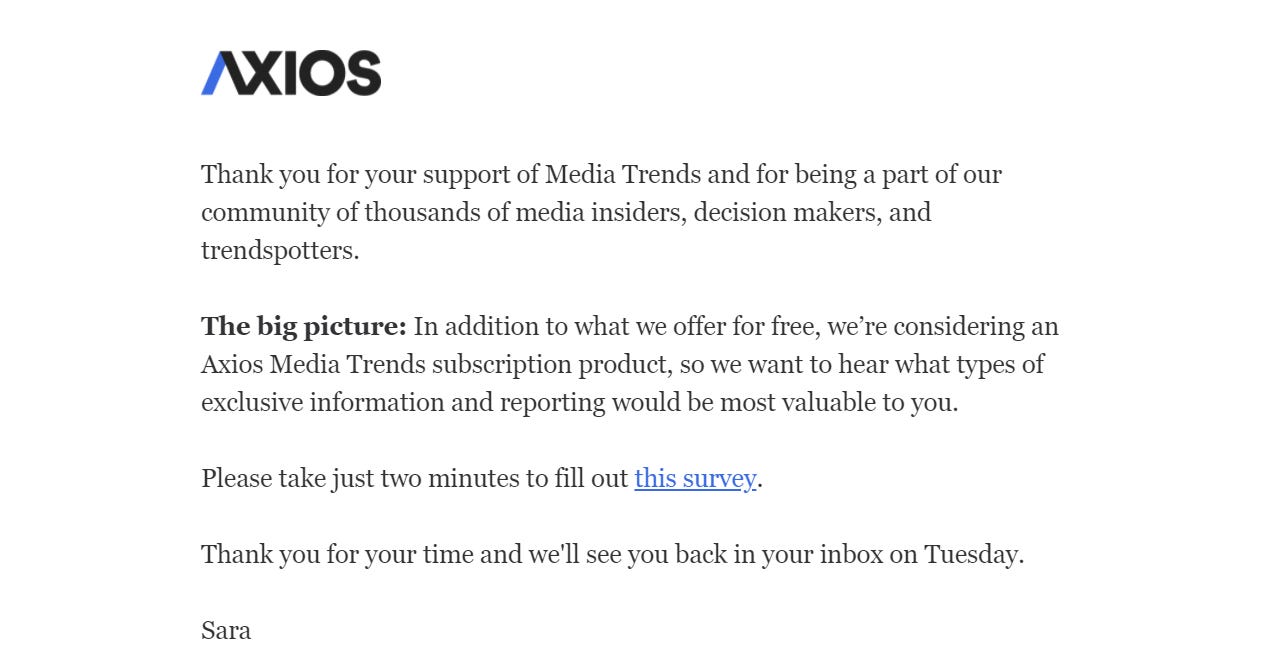Will people listen to multiple daily news podcasts?

Welcome! I'm Simon Owens and this is my media newsletter. If you've received it, then you either subscribed or someone forwarded it to you. If you fit into the latter camp and want to subscribe, then you can click on this handy little button:
Let’s jump right into it…
Will people listen to multiple daily news podcasts?
Nieman Lab reports on the LA Times’s entry into the daily podcast space, and of course any article on this subject needs to address the elephant in the room: The New York Times’s massively successful The Daily.
“Nothing against the far bigger podcasts out there, like Post Report and The Daily. I know Post Reports did a Guatemalan episode but they’re not going to bring that diversity of voices that we’re going to bring None of them are,” [LA Times podcast host Gustavo Arellano] says. “Here, we’re just reporting on what’s in front of us. We don’t have that far to go, frankly.”
Still, he acknowledges that the LA Times is starting from behind. “Look, let’s be honest. We’re late to the game. We’re five years late to the podcast game. We’re following outlets with far more reporters, far more listeners, because they’ve been ahead,” he said. “The only way we’re going to win at our game is by differentiating ourselves in a way where people will say, ‘Okay, I already listened to, for instance, What a Day by Crooked Media but I have to listen to The Times as well because they’re going to bring me a completely different story that no one else is bringing.”
I’ve interviewed the people behind a couple of other daily podcasts, and they too claimed that their show could be listened to in addition to The Daily.
I’m pretty skeptical to this idea that consumers will listen to multiple daily news podcasts. Most podcast listening is built into a person’s day; for me, it’s when I’m going on my post-lunch walk or exercising, but for others it might be during their work commute. This means the vast majority of podcast consumers max out at an hour of listening a day.
If you listen to multiple daily news podcast, then that would leave virtually no time for non-daily shows. I doubt many people will sacrifice listening to their favorite for-pleasure podcasts just so they can pack in more news.
Instead, I think people will settle on a single daily news podcast in the same way that our grandparents chose a single network news broadcaster. Just as people in the 1970s chose between Walter Cronkite and NBC’s Chet Huntley and David Brinkley, podcast listeners will pick between The Daily and Up First. Whether the LA Times wants to admit to it or not, it will be competing directly with The Daily.
REMINDER: I interviewed the LA Times’s head of podcasts about the publisher’s strategy a few months back.
The Athletic raises its prices
Variety reports:
Starting Friday, July 16, The Athletic will charge for new and existing subscribers $71.99 per year. Previously, a yearly subscription cost $59.99. Annual subscribers will still pay less than people who pay month by month. The cost of monthly access to the site will remain the same, $7.99.
There are two ways that subscription publishers can generate more revenue: get more subscribers or convince their current subscribers to pay more.
It’s worth noting that The Athletic has pursued acquisitions/mergers with both Axios and The New York Times in recent months, a possible indication that it’s maxed out on VC infusions and now either needs to be acquired or generate a profit.
The Athletic famously eschewed advertising, choosing instead to focus solely on paid subscriptions. If it is indeed cash strapped, then you have to wonder whether its executives are rethinking their dogmatic opposition to advertising.
Axios might finally launch a subscription product
When Axios launched, its founders touted a coming $10,000 annual subscription tier that it would sell to B2B audiences, but that subscription product never materialized as the company doubled down on native advertising.
Well, we finally might get that subscription product after all. Here’s an email I received today:
Will is stick to the $10k price tag? Will it offer a bundle or sell subscriptions by vertical? Who knows!
REMINDER: I interviewed Axios’s technology editor a few months back.
Should we be impressed by Facebook’s $1 billion creator fund?
Mark Zuckerberg announced this week that Facebook is setting aside $1 billion to pay its video creators between now and the end of 2022.
I’ve written about this before in regard to Snapchat’s creator fund, but I don’t think this is a great longterm solution for paying creators. It’s a fine way to jumpstart creator monetization, but if you’re not building out tools to help creators grow sustainable businesses, then you’re not actually providing much support to the community.
YouTube, on the other hand, has spent the last decade devising ways for its creators to directly participate in the platform’s success. This started with ad revenue sharing and has expanded into things like merch and subscriptions.
BuzzFeed news reports that Instagram influencers have approached Zuckerberg’s announcement with extreme skepticism, especially since the creator fund seems biased toward video. "Influencers have been complaining for months that Instagram’s Reels obsession has made their actual, genuine content perform worse,” writes BuzzFeed’s Stephanie McNeal.
The demise of Knewz
Nieman Lab provides a good post mortem on Knewz, which was News Corp's attempt at a Drudge-like news aggregator.
Why are news website so terrible?
Monday Note covers the multiple ways that news websites create terrible user experiences:
I would love to ask a digital manager: do you often use your internal search system? No, you don’t, because it’s a terrible experience. In case you wonder, your own staff and your readers use Google to unearth your stories. In many cases, there are no auto-complete or auto-correct functionalities, no advanced search features, and no search history. And I’m not mentioning the inability to filter a search by the type of article, like profiles of people for instance, or stories of a certain length and depth. If you try to find a great piece in publication XYZ from three months earlier about something that is back in the news, get ready for some digging. These people are unable to value their evergreen production.
Most news publishers have technical challenges that the major social media platforms solved a decade ago. For instance, I can't remember the last time I had to enter my Facebook login, and yet every publisher I subscribe to forgets who I am once a month.



